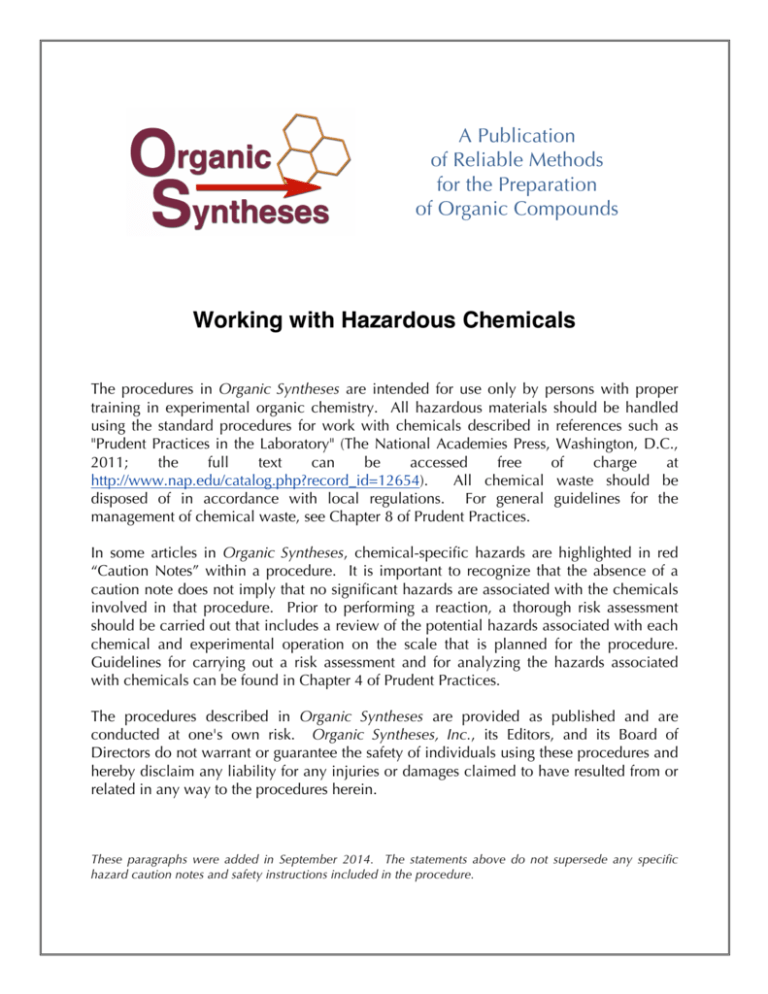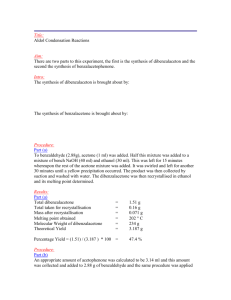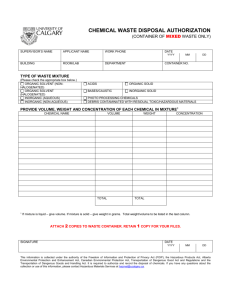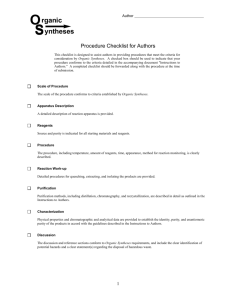
A Publication
of Reliable Methods
for the Preparation
of Organic Compounds
Working with Hazardous Chemicals
The procedures in Organic Syntheses are intended for use only by persons with proper
training in experimental organic chemistry. All hazardous materials should be handled
using the standard procedures for work with chemicals described in references such as
"Prudent Practices in the Laboratory" (The National Academies Press, Washington, D.C.,
2011;
the
full
text
can
be
accessed
free
of
charge
at
http://www.nap.edu/catalog.php?record_id=12654).
All chemical waste should be
disposed of in accordance with local regulations. For general guidelines for the
management of chemical waste, see Chapter 8 of Prudent Practices.
In some articles in Organic Syntheses, chemical-specific hazards are highlighted in red
“Caution Notes” within a procedure. It is important to recognize that the absence of a
caution note does not imply that no significant hazards are associated with the chemicals
involved in that procedure. Prior to performing a reaction, a thorough risk assessment
should be carried out that includes a review of the potential hazards associated with each
chemical and experimental operation on the scale that is planned for the procedure.
Guidelines for carrying out a risk assessment and for analyzing the hazards associated
with chemicals can be found in Chapter 4 of Prudent Practices.
The procedures described in Organic Syntheses are provided as published and are
conducted at one's own risk. Organic Syntheses, Inc., its Editors, and its Board of
Directors do not warrant or guarantee the safety of individuals using these procedures and
hereby disclaim any liability for any injuries or damages claimed to have resulted from or
related in any way to the procedures herein.
These paragraphs were added in September 2014. The statements above do not supersede any specific
hazard caution notes and safety instructions included in the procedure.
DOI:10.15227/orgsyn.002.0001
Organic Syntheses, Coll. Vol. 1, p.78 (1941); Vol. 2, p.1 (1922).
BENZALACETOPHENONE
[Chalcone]
Submitted by E. P. Kohler and H. M. Chadwell.
Checked by H. T. Clarke and R. P. Leavitt.
1. Procedure
A solution of 218 g. (5.5 moles) of sodium hydroxide in 1960 g. of water and 1000 g. (1225 cc.) of
95 per cent alcohol are introduced into a 5.5-l. bottle which is loosely covered with a perforated disk of
cardboard, supplied with an effective stirrer, and supported in a larger vessel so as to permit cooling
with cracked ice. Into the alkaline solution, 520 g. (4.3 moles) of pure acetophenone (Note 1) is poured,
the bottle is rapidly surrounded with cracked ice, and the stirrer started; 460 g. (4.3 moles) of u. s. p.
benzaldehyde (Note 2) is then added at once. The temperature of the mixture should not be below 15°
and it should not be allowed to rise above 30° during the reaction (Note 3). If it tends to do so, the
stirring is not sufficiently vigorous.
It is advantageous, though not essential, to inoculate the mixture with a little powdered
benzalacetophenone after stirring for one-half hour. After two to three hours, the mixture becomes so
thick that the stirring is no longer effective. The stirrer is then removed and the mixture left to itself in
an ice box for about ten hours. The mixture now is a thick paste composed of small shot-like grains
suspended in an almost colorless liquid. It is cooled in a freezing mixture and then either centrifuged or
filtered on a large Büchner funnel, washed with water until the washings are neutral to litmus, and
finally washed with 200 cc. of 95 per cent alcohol, which has previously been cooled to 0°. After
thorough drying in the air, the crude product weighs about 880 g. (97 per cent of the theoretical amount)
and melts at 50–54°. It is sufficiently pure for most purposes but tenaciously holds traces of water. It is
most readily purified by recrystallization from four to four and one-half times its weight of 95 per cent
alcohol (Note 4). Eight hundred and eighty grams of crude product give 770 g. (85 per cent of the
theoretical amount) of light yellow material (m. p. 55–57°) and 40–50 g. that require recrystallization.
2. Notes
1. The acetophenone should be as pure as possible (m. p. 20°). Commercial acetophenone contains
variable quantities of impurities which reduce the yield. By distilling commercial acetophenone with the
help of a good still-head (preferably under diminished pressure) and using only the fraction which boils
at 201–202° (76–77° /10 mm.) greater quantities of benzalacetophenone can be obtained than by using
the entire sample.
2. Commercial benzaldehyde can be used in place of the purer product, but the amount used must be
increased to make up for the impurities which are present.
3. If the temperature is too low, or the stirring too slow, the product separates as an oil, which later
solidifies in large lumps. If the temperature is allowed to rise above 30°, secondary reactions diminish
both the yield and the purity of the product. The most favorable temperature is 25°.
4. In recrystallizing benzalacetophenone, the alcohol should be saturated at 50°. If the solution is
saturated above this temperature, the benzalacetophenone tends to separate as an oil. The solution
should be allowed to cool gradually, and should finally be chilled in a freezing mixture.
3. Discussion
Benzalacetophenone can be prepared from benzaldehyde and acetophenone, by the use of either
acid1 or alkaline condensing agents. The alkaline agents are superior and those generally used are a 30
per cent solution of sodium methoxide at low temperatures2 and alcoholic sodium hydroxide.3
Preliminary experiments showed that condensation with sodium methoxide requires a long time and
gives a product which is difficult to handle in large quantities.
This preparation is referenced from:
z
z
z
z
z
z
Org. Syn. Coll. Vol. 1, 101
Org. Syn. Coll. Vol. 1, 205
Org. Syn. Coll. Vol. 2, 167
Org. Syn. Coll. Vol. 2, 236
Org. Syn. Coll. Vol. 2, 498
Org. Syn. Coll. Vol. 5, 1135
References and Notes
1. Claisen and Claparède, Ber. 14, 2463 (1881); Straus and Grindel, Ann. 439, 276 (1924); Breslow
and Hauser, J. Am. Chem. Soc. 62, 2385 (1940).
2. Claisen, Ber. 20, 657 (1887).
3. Kostanecki and Rossbach, Ber. 29, 1492 (1896); Schlenck and Bergmann, Ann. 463, 234 (1928).
Appendix
Chemical Abstracts Nomenclature (Collective Index Number);
(Registry Number)
alcohol (64-17-5)
sodium hydroxide (1310-73-2)
Benzalacetophenone,
Chalcone (94-41-7)
benzaldehyde (100-52-7)
Acetophenone (98-86-2)
sodium methoxide (124-41-4)
Copyright © 1921-2005, Organic Syntheses, Inc. All Rights Reserved





